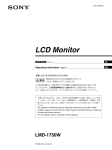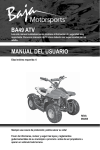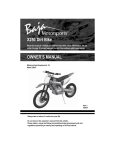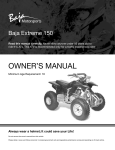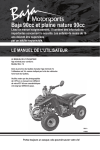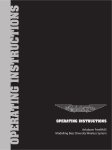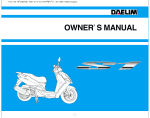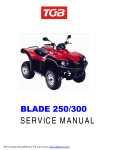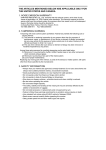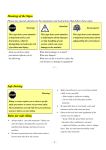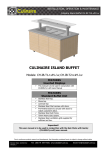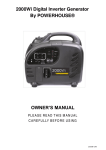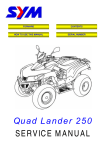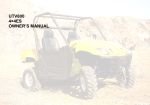Download BO250 UTV - Baja Motorsports
Transcript
BO250 UTV Read this manual carefully. It contains important safety information. No one under the age of 16 should operate this UTV OWNER’S MANUAL Minimum Age Requirement 16 Rev.C 021309 Always wear a helmet; It could save your Life! Please obtain, review, and follow provincial / municipal government acts and regulations pertaining to owning and operating an off-road vehicle. Congratulations on your purchase of the Baja Motorsports UTV It is warranted to be free of manufacturing defects in the material of workmanship for a period of 90 days from the date of purchase. During the warranty period BAJA, INC. will at its option, repair, provide replacement parts or replace your Baja Motorsports UTV at no charge. This warranty does not cover normal wear items or damage caused by neglect or misuse of the product. Engine Warranty – 90 days Frame Warranty – 90 days Warranty is void if: Frame is bent or broken due to abuse Wheels are bent or broken Fender bent or broken due to abuse Any sign of impact, accident, jumping, spin-outs or roll over. BAJA, INC. is not liable for any damage claim or liability claim person or otherwise resulting from the operation of this product in any way. Should you experience a problem or need to return your Baja Motorsports UTV for repair, please call the BAJA MOTORSPORTS customer service department TOLL FREE at 1-888-863BAJA (2252) between the hours of 7am and 5pm Monday thru Friday PST and Saturday 8am to 4pm PST. During DST hours change to MT. You will be instructed how to proceed. A COPY OF THE SALES RECEIPT IS REQUIRED. 2 ! WARNING This manual should be considered as a permanent part of the vehicle and should remain with the vehicle when resold or otherwise transferred to a new user or operator. The manual contains important safety information and instructions which should be read carefully before operating the vehicle. ! WARNING The engine exhaust from this product contains chemicals known to the State of California to cause cancer, birth defects or other reproductive harm. CALIFORNIA PROPOSITION 65 3 TABLE OF CONTENTS NOTICE TO USERS....................................................................................... BAJA 250cc UTV........................................................................................... LOCATION OF WARNING LABELS.............................................................. CONTROLS AND INDICATORS.................................................................... KEY SWITCH...................................................................................... HEADLIGHT SWITCH......................................................................... EMERGENCY SHUT OFF SWITCH.................................................... HOUR METER..................................................................................... REVERSE INDICATOR LIGHT............................................................ NEUTRAL INDICATOR LIGHT............................................................ FORWARD INDICATOR LIGHT........................................................... FUEL INDICATOR LIGHT.................................................................... TEMPERATURE INDICATOR LIGHT.................................................. TRANSMISSION GEAR SHIFT LEVER............................................. ACCELERATOR PEDAL.................................................................... BRAKE PEDAL.................................................................................. PARKING BRAKE LEVER................................................................. OPERATION INSTRUCTIONS....................................................................... STARTING THE UTV.......................................................................... STOPPING THE UTV.......................................................................... PARKING THE UTV............................................................................. BED LATCH......................................................................................... LOADING AND UNLOADING CARGO BED...................................... TOWING WITH THE UTV............................................................................... TRANSPORTING THE UTV........................................................................... STORING THE UTV....................................................................................... PREPARATION FOR EXTENDED STORAGE................................... RETURNING STORED UTV TO SERVICE........................................ OPERATING YOUR UTV............................................................................... WHAT YOU SHOULD KNOW BEFORE RIDING.......................................... INSPECTION BEFORE RIDING.................................................................... SAFETY GEAR.............................................................................................. BREAK-IN...................................................................................................... STARTING THE ENGINE.............................................................................. BRAKING...................................................................................................... OPERATION ON HILLS................................................................................ OPERATING OVER OBSTACLES................................................................ OPERATING THROUGH WATER................................................................. OPERATING IN COLD WEATHER............................................................... DRESSING FOR COLD WEATHER RIDING................................................ OPERATING YOUR UTV ON SNOW AND ICE............................................. 4 6 10 11 14 14 14 14 14 14 14 14 14 14 15 15 15 15 16 16 16 16 16 17 18 18 18 19 20 21 21 22 24 25 26 30 31 32 33 34 35 36 TABLE OF CONTENTS PERIODIC MAINTENANCE SCHEDULE....................................................... PERIODIC LUBRICATION SCHEDULE............................................. AIR FILTER.................................................................................................... RADIATOR..................................................................................................... ENGINE OIL................................................................................................... ENGINE OIL LEVEL CHECK............................................................. ENGINE OIL CHANGE....................................................................... TRANSMISSION OIL CHANGE......................................................... REAR DIFFERENTIAL OIL CHANGE........................................................... FUELING INSTRUCTIONS............................................................................ BATTERY....................................................................................................... PREPARING THE BATTERY............................................................. HOW TO INITIALLY CHARGE THE BATTERY................................. BATTERY REPLACEMENT............................................................... ADJUSTMENTS............................................................................................ SUSPENSION.................................................................................... SPARK PLUG..................................................................................... TIRES.................................................................................................. VEHICLE CLEANING.................................................................................... CLEANING PROCEDURE................................................................. PREPARATION FOR CLEANING...................................................... TROUBLESHOOTING................................................................................... SERIAL NUMBER LOCATIONS................................................................... SPECIFICATIONS......................................................................................... EMISSION CONTROL SYSTEM WARRANTY.............................................. 5 37 37 38 39 39 39 41 41 42 43 44 45 46 47 48 48 48 50 51 51 51 52 53 54 55 NOTICE TO USERS Please read this manual and follow all instructions carefully. To emphasize the special information, the symbol and the words WARNING or CAUTION have some special meanings. Pay attention to the messages. WARNING Indicates a potential hazard that could result in death or injury. CAUTION Indicates a potential hazard that could result in vehicle damage. NOTE: Indicating special information which is to make maintenance easier or instructions clearer. WARNING and CAUTION are arranged like this: WARNING-or-CAUTION The first part will identify a POTENTIAL HAZARD. The second part will describe WHAT COULD HAPPEN if you ignore the WARNING or CAUTION. The third part will describe HOW TO AVOID THE HAZARD. This user’s manual contains important safety and maintenance information. Read it carefully before riding. Failing to follow the warnings contained in this manual could result in INJURY or DEATH. It is important that this manual remain with the vehicle when you transfer it to another user or owner. All information, illustrations, photographs and specifications contained in this manual are based on the latest product information available at the time of publication. Due to improvements or other changes, there will be some discrepancies in this manual. We reserve the right to make product changes at any time, without notice and without incurring any obligation to make the same or similar changes to the vehicle previously built or sold. 6 NOTICE TO USERS We believe in conservation and protection of the earth’s natural resources. We encourage every vehicle owner and operator to do the same by obeying posted signs and riding only in areas designated and approved for off-road recreational use. NOTICE TO USERS THIS UTV IS NOT A TOY. IT COULD BE HAZARDOUS TO OPERATE. A UTV is different from other vehicles including motorcycles and cars. A collision or rollover could occur quickly, even during routine maneuvers such as turning and driving on hills or over obstacles if you fail to take proper precautions. WARNING SEVERE INJURY OR DEATH can result if you do not follow these instructions. · Read this manual and labels on the UTV carefully and follow the operations procedures as described. · Never operate the UTV without proper instructions. · Always avoid operating an UTV on paved surfaces, including: sidewalks, paths, parking lots, driveways, streets, roads, and highways. Never operate this or any UTV on a public street, road or highway where motor vehicles are in operation. · Never operate an UTV without wearing a DOT approved motorcycle helmet which fits properly. Operators should also wear eye protection (goggles or face shield), gloves, boots, long-sleeved shirt or jacket, and long pants. · Never use alcohol or drugs before or during operation of UTV. · Driver and passenger should always wear seat belts 7 NOTICE TO USERS · Never operate this UTV at excessive speeds. Always operate at a speed that is proper for the terrain, visibility, operating conditions, and the operator’s skill / experience. · Never attempt jumps or other stunts. · Always inspect the UTV each time before use to ensure it is in a safe operating condition. Always follow the inspection and maintenance procedures and schedules described in this manual. · Always as an operator keep both hands on steering wheel. Operator and passenger should always keep hands, arms, legs and feet inside UTV while in operation. · Always go slow and be extremely careful when operating on unfamiliar terrain. Always be alert to the changing terrain conditions when operating the UTV. · Never operate on excessively rough, slippery or loose terrain until you have learned and practiced the necessary skills to control the UTV on such terrain. · Never operate the UTV on hills that are too steep for the UTV or for the operator’s ability. Practice on smaller hills before attempting larger hills. Never attempt climbing hills greater than a 15 degree incline. · Check the terrain carefully before you start up any hill. Never climb hills with excessively slippery or loose surfaces. Never go over the top of a hill at high speeds. · Check the terrain carefully before starting to go down any hill. Never go down a hill at an angle that would cause the vehicle to lean sharply to one side. Go straight down the hill if possible. · Always use proper procedures if stalling while climbing a hill. Place UTV in reverse and back down slowly using brakes as needed. To avoid stalling, maintain a steady speed when climbing a hill. If you stall or roll backwards, follow the special procedure for braking described in this manual. 8 NOTICE TO USERS · Always check for obstacles before operating in a new area. Never attempt to operate over large obstacles, such as large rocks or fallen trees. Always follow proper procedures when operating over obstacles as described in this manual. · Always be careful when skidding or sliding. Learn to safely control skidding or sliding by practicing at low speeds and on level, smooth terrain. On extremely slippery surfaces, such as ice, go slow and be very cautious in order to avoid going out of control when skidding or sliding. · Never operate a UTV in fast flowing water or in water deeper than 4 inches. Remember that wet brakes can reduce stopping ability. Test your brakes after leaving water. If necessary, apply them several times to let friction linings dry out. · Always use the tires with proper size and type tires specified in this manual. Always maintain proper tire pressure as described in this manual. · Never modify a UTV through improper installation of accessories. · Never exceed the stated load capacity for an UTV. Cargo should be distributed properly and attached securely. Reduce speed and follow instructions in this manual for carrying cargo. Allow longer distance for braking. · Be sure to remove any/all cargo before raising the cargo bed or servicing UTV. Maximum load capacity in cargo bed is 400lbs. (181kg) Overloading the cargo bed will cause damage and danger. Make sure all persons are clear before lowering cargo bed. Do not drop the cargo bed, slowly lower. Failure to follow these warnings may result in severe injury or death. · The combined weight of the rider and any accessories or cargo must never exceed the vehicle’s load capacity of 850 lbs. (385kg) 9 BAJA 250CC UTV Forward/Reverse lever Headrests Brush guard Cargo bed latch Cargo bed Front bumper Radiator fill cap Accelerator and Brake pedals Left Parking brake lever Mirror Passenger Handle Seat Belts Steering wheel Key switch Cargo bed Front Shocks Rear Shocks Gas tank Rear wheel Front wheel Right 10 LOCATION OF WARNING LABELS 3 4 1 6 5 2 7 Located on left and right side panels 8 9 10 5 11 LOCATION OF WARNING LABELS 2 1 4 3 12 LOCATION OF WARNING LABELS 5 6 8 7 9 10 13 CONTROLS AND INDICATORS KEY SWITCH To start the vehicle turn key switch right (CW) and hold until engine is running smoothly. The engine should now idle. Turn key switch left (CCW) to turn engine off. NOTE: Key can only be removed when engine is off. EMERGENCY SHUT OFF SWITCH For engine to run, the Emergency shut off switch needs to be placed in the “ON” position. HEADLIGHT SWITCH To turn headlights on press the headlight button. Headlights should be off when engine is not running to prevent the battery from loosing life. HOUR METER The hour meter (located under driver seat) only operates when the engine is running. It tracks accumulative operating time of the engine so you know when to perform the periodic maintenance. Headlight switch Emergency shut off Switch Key Switch REVERSE INDICATOR LIGHT This light will illuminate when the UTV is in reverse. Hour meter NEUTRAL INDICATOR LIGHT This light will illuminate when the UTV is in neutral. FORWARD INDICATOR LIGHT This light will illuminate when the UTV is in Forward. FUEL INDICATOR LIGHT This light will illuminate when fuel is low. TEMPERATURE INDICATOR LIGHT This light will illuminate when engine is overheating. Neutral Indicator Light Forward Indicator Light Reverse Indicator Light Temperature Indicator Light Fuel Indicator Light 14 CONTROLS AND INDICATOR TRANSMISSION GEAR SHIFT LEVER The transmission gear shift lever is located between the driver and passenger seat cushion. To put the transmission in forward, place lever down. To put transmission in reverse, pull lever back. NOTE: Be sure to depress the brake pedal before shifting in any position. Transmission gear shift lever ACCELERATOR PEDAL By depressing this pedal the vehicles speed will increase in either forward or reverse. When the pedal is released it will return to the original position and the engine will idle. BRAKE PEDAL This pedal will slow or stop the vehicle when depressed Accelerator Pedal Brake Pedal PARKING BRAKE LEVER The parking brake lever is located between the driver and passenger seats. Use this lever whenever parking the machine, especially on a slope. Apply the parking brake by pulling up. Release by pressing button on end of lever and lower completely. Parking Brake Lever 15 OPERATION INSTRUCTIONS STARTING THE UTV 1. Read warning and loading labels, be sure to secure load (if any). 2. Study and understand all controls and indicators. 3. Fasten seat belt including passenger (if any). 4. Depress the brake pedal, turn ignition key clockwise and hold. 5. Keeping the brake pedal depressed select the direction of travel placing the drive select lever in either forward or reverse. Release the parking brake. 6. Release the brake pedal and slowly depress the accelerator pedal. NOTE: Never shift from forward to reverse or vice versa until the vehicle is completely stopped. STOPPING THE UTV Driving through water may affect the brakes. Check the effectiveness of the brakes after driving through water by gently depressing the brake pedal. If the vehicle does not slow down continue to depress the brake pedal until the brakes dry out. PARKING THE UTV 1. Always engage the parking brake when stopping to ensure the vehicle will not roll. 2. Turn the ignition key switch to the off position and remove key. 3.. Wheel chocks are recommended if parking on an incline. BED LATCH To lift the bed pull the latch handle upward and the hydraulic stand will secure the bed. WARNING Be sure to keep hands and all body parts away from crush area. Failure to do so could result in severe injury or death. Bed latch handle 16 OPERATION INSTRUCTIONS WARNING Make certain the hydraulic stand is secure when working under the bed. Failure to do so may result in severe injury or death. WARNING Do not lower cargo bed until all persons and objects are clear from cargo bed area. Gently lower cargo bed, do not drop bed down. Failure to do so may result in severe injury or death. To lower the cargo bed lift the prop rod and push rod toward the vehicle to free it from the track. Gently lower bed, do not drop. LOADING AND UNLOADING CARGO BED • Engage parking brake before loading anything. • Never allow riders in cargo bed. • When driving uphill, downhill or on uneven terrain reduce the load and speed. • Never exceed the maximum weight capacity of the vehicle. • Overloading the vehicle can affect vehicle handling and cause components to fail resulting in injury or death. • Reduce speed and sudden stops when in reverse to prevent the vehicle from flipping backward. • Do not load tailgate. Tailgate must be in the upright position and secure when vehicle is in motion. • Avoid sudden starts, stops and turns to help prevent load from shifting and possibly causing the vehicle to overturn. • Make sure cargo is well secured to prevent is from shifting and possibly causing vehicle overturn. • The center of gravity should never exceed 15 inches from above the bottom of the cargo bed. • Remove cargo from bed before raising vehicle (lift, hoist, jack, etc.). • Avoid stopping on a hill with cargo in cargo bed. If it is necessary to stop on a hill avoid sudden starts or rolling backward and sudden stopping. Maximum payload capacity: 850lbs. (385kg) Maximum cargo capacity: 400lbs. (181kg) Maximum trailer tongue weight: 100lbs. (45kg) 17 OPERATION INSTRUCTIONS TOWING WITH THE UTV • Never tow a vehicle or trailer on public streets or highways. • Speed should be reduce when towing. • Use extreme caution. • Never allow riders in or on whatever is being towed. • Total vehicle capacity (load weight, weight of whatever is being towed) should not exceed the previous weight specified. • Avoid sudden starts, stops and tight turns. • Avoid stopping on a hill. If it is necessary to stop on a hill avoid sudden starts or rolling backward and sudden stopping. • Be sure to always use the parking brake and chocks (if accessible) TRANSPORTING THE UTV • Never allow riders on the vehicle. • Avoid sudden starts, stops and tight turns. • Avoid stopping on a hill. If it is necessary to stop on a hill avoid sudden starts or rolling backward and sudden stopping. • Reduce speed. • Tie-down securely and set the parking brake. • Never transports with any load in the cargo bed. USE AN APPROVED TRAILER THAT HAS A LOAD RATING OF AT LEAST 2000LBS. PER VEHICLE BEING TRANSPORTED AND OBSERVE ALL WARNING PRECAUTIONS. STORING THE UTV DANGER Do not drain gasoline when engine is hot or running. Clean any spilled gasoline before operating the vehicle. Store gasoline in an approved container only. Store in a well-ventilated area away from sparks, open flames, heaters etc. Keep gasoline out of reach of children. Do not siphon gasoline from vehicle. 18 OPERATION INSTRUCTIONS WARNING Remove the key and set the parking brake. Do not charge a frozen battery or batteries with bulging cases. Discard batteries according to state and local environmental legal guidelines for battery disposal. Frozen batteries may explode. CAUTION Batteries with low charge will freeze at low temperatures. PREPARATION FOR EXTENDED STORAGE 1. Make sure there is no load in the cargo bed. 2. Store in a cool, dry place. This will help prevent the battery from loosing charge. 3. Drain all gasoline from fuel tank and seal. 4. Run engine until all fuel in carburetor and fuel lines are gone and the engine stalls. 5. Loosen but do not remove the carburetor drain screw allowing the remaining fuel to drain into a container, then pour the fuel from container into the vehicle fuel tank. 6. Fill the fuel tank 1 inch from the top of fuel tank and add fuel stabilizer. 7. Disconnect fuel tank line from fuel tank vent nipple. 8. Plug the fuel tank vent line air tight. 9. Disconnect battery cables, making sure to disconnect the negative cable first. 10. Make sure the battery is clean and free of corrosion. Wash the terminals with baking soda and water (1 cup baking soda per 1 gallon water). Rinse the solution be sure the solution does not enter the battery. Make sure the terminals are tight, let them dry and coat with Battery Terminal Protector Spray. 11. Remove the spark plug and pour 1/2 of SAE 10 weight oil into the engine through the spark plug hole and manually turn the crankshaft several times and reinstall the spark plug. 12. Adjust tires to the recommended tire pressure. 13. Perform any semi-annual periodic lubrication including the front suspension. 14. Thoroughly clean the vehicle. 15. Do not set the parking brake. To prevent the vehicle from rolling, choke the wheels. 19 OPERATION INSTRUCTIONS RETURNING STORED UTV TO SERVICE 1. Restore the fueling system to operational standards. 2. Remove plug from fuel tank vent. 3. Connect fuel vent line to fuel tank vent. 4. Connect the battery cables making sure to connect the positive cable first. 5. Engage the parking brake and crank the engine until fuel has pumped into the carburetor and fuel lines and the engine starts. Turn the engine off. NOTE: Engine may smoke for awhile when running it the first time after storage. 6. Adjust the tires to recommended tire pressure. OPERATING YOU UTV WHAT YOU SHOULD KNOW BEFORE RIDING Before riding, you should read all the following information carefully. If you are properly prepared, you will have a more enjoyable ride. Before riding, you should find a good place to practice the skills. Find a flat, open area with enough space to practice the new skills. 20 OPERATING YOUR UTV WARNING Operating this UTV without proper instruction could be hazardous. The risk of riding could increase greatly if you do not know how to operate the UTV properly under different situations and in different types of terrain. Beginners and inexperienced operators should complete a certified training course. You should regularly practice the skills learned in the course and the operating techniques described in this user’s manual. For more information about the training course, visit www.svia.org or call 800-887-2887. For more information on UTV safety and other provincial and municipal governmental acts and regulation pertaining to owning and operating an offroad vehicle visit one of the following web-sites: www.svia.org www.cpsc.gov www.mmic.ca/CATV/ Make sure that it is legal to ride in the area you selected. Review the local laws and make sure you are not trespassing. Call the police if you don’t know where you can ride. Protect your riding areas. When you are riding, remember to keep the terrain in good condition. Don’t destroy plants, trees or other vegetation. Don’t litter and don’t bother wildlife. With your help, your riding area can remain open for use in the future. After you have found a good place to practice, review the control system on your UTV before riding. Learn to find these controls without looking for them, because you will not have time to look for them when you are riding. Canadian residents must obtain, review, and follow all provincial and municipal government acts and regulations pertaining to owning and operating an off-road vehicle. 21 OPERATING YOUR UTV INSPECTION BEFORE RIDING ITEM TO CHECK CONTENT Steering Smoothness; No restriction of movement; No play or looseness Brakes Proper brake lever free play; enough brake force; Parking brake effectiveness Tires Proper air pressure; Enough tread depth; No cracks, rips, or other damages Fuel Enough fuel for the intended trip; Fuel hose connected securely; No damage to fuel tank or cap; Fuel tank cap closed securely Engine oil Proper level – Check the oil. Make sure it is full. Throttle Proper free play of gas pedal; Smooth response; Quick return to idle position General condition Bolts and nuts are tight; No rattle from any parts of the engine when running; No visible evidence of Damage WARNING Failing to inspect the UTV before operating could be hazardous. Failing to perform proper maintenance could also be hazardous. Failing to inspect and maintain your UTV could increase the chances of an accident or equipment damage Always inspect your UTV each time before riding, and make sure it is in a safe operating condition. Refer to the INSPECTION BEFORE RIDING and PERIODIC MAINTENANCE SCHEDULE. 22 OPERATING YOUR UTV WARNING Operating this UTV with improper tires, or improper tire air pressure could be hazardous. If you use improper tires or improper air pressure, you may lose control of the UTV. This will cause an accident. Always use the tires with size and type tires specified in this user’s manual. Always maintain proper tire air pressure as described in the TIRES section. WARNING Overloading could be hazardous. Overloading could cause changes in vehicle handling and could lead to an accident. Check the condition of the UTV to make sure that the UTV does not have mechanical problems or you could get stranded when you ride. Before riding the UTV, be sure to check the above items. Be sure your UTV is in good condition to ensure the safety of the rider(s). WARNING Checking maintenance items when the engine is running could be hazardous. You could be severely injured if your hands or clothing get caught in moving UTV parts. Shut the engine off when performing maintenance checks, except checking the throttle. 23 OPERATING YOUR UTV SAFETY GEAR A DOT approved motorcycle helmet is the most important part of you safety gear. A DOT approved motorcycle helmet can help prevent a serious head injury. Choose a helmet that fits snugly. Motorcycle dealers can help in selecting a good quality helmet which fits properly. WARNING Operating this UTV without wearing an approved DOT motorcycle helmet, eye protection, and protective clothing could be hazardous. Operating without an approved DOT motorcycle helmet or eye protection increases your chances of a severe head injury or death in an accident. Operating without protective clothing also increases your chances of severe injury in an accident. Always wear an approved DOT motorcycle helmet which fits properly. Always wear eye protection (goggles or face shield). You should also wear gloves, boots, long sleeve shirt or jacket, and long pants. You should wear eye protection when you ride. If a rock or a branch hits your eyes, you could be severely injured. Wear goggles or a face shield. Wear proper clothing when you ride. The proper clothes can protect you from injury. Wear a good pair of gloves, strong boots that are over the ankle, long pants, and a long sleeve shirt. 24 OPERATING YOUR UTV BREAK-IN The first 10 hours is the most important in the life of your vehicle. Proper operation during this break-in period will be helpful for assuring maximum life and performance of your new vehicle. The following guidelines explain proper break-in procedures. Maximum Throttle Opening Recommendation During the first 10 hours of operation, you should always use less than ½ throttle opening. Vary the Engine Rotating Speed Vary the engine rotating speed during the break-in period. This allows the parts to “load” and then “unload” (allowing the parts to cool). Although it is essential to place some stress on the engine components during break-in, you must be careful not to load the engine too much. Avoid Constant Low Rotating Speed Operating the engine at constant low rotating speed (light load) can cause parts to glaze and not seal properly. Allow the engine to accelerate freely without exceeding the maximum throttle limit. Allow the Engine Oil to Circulate Before Riding Allow enough idling time after warm or cold engine starting. This allows the lubricating oil to reach all critical engine components. Observe Your Initial and Most Critical Service The initial service (break-in maintenance) is the most important service that your vehicle will receive. Observing a proper break-in operation, will help engine components seal properly. Maintenance required as part of the initial service includes proper adjustments, tightening of all bolts & nuts, and replacement of dirty oil. Timely performance of this service will help you get the best service life and performance of the engine. 25 OPERATING YOUR UTV STARTING THE ENGINE Before attempting to start the engine, make sure to follow these steps. 1. 2. 3. 4. Any maintenance checks have been made. Parking brake is applied. Driver and passenger (if any) is seated with seat belt on. Brake pedal is applied. WARNING The UTV could start moving as soon as you start the engine. Unexpected movement could cause you to lose control of the UTV. Be sure to set the parking brake before you start the engine. WARNING Running your UTV indoors where there is little or no ventilation could be hazardous. Breathing in exhaust gases from the UTV could cause severe injury. Always run your UTV outdoors where there is fresh air. 26 OPERATING YOUR UTV WARNING Operating this UTV on paved surfaces, including sidewalks, paths, parking lots, driveways and streets could be hazardous. UTV tires are designed for off-road use. Paved surfaces may seriously affect handling and control of the UTV, and may cause the vehicle to lose control. Avoid operating the UTV on paved surfaces if possible. If you must ride on a paved surface, go slow and do not make sudden turns or stops. WARNING Operating this UTV on public streets, roads or highways could be hazardous. You may collide with another vehicle if you ride on the public roads. Never operate this UTV on any public street, road or highway, even dirt or gravel street, roads, or highway. In many states is it illegal to operate UTVs on public streets, roads and highways. WARNING Operating this UTV at excessive speeds could be hazardous. Riding at excessive speeds increases your chances of losing control of the UTV, which could result in an accident. Always go at a speed that is proper for the terrain, visibility, operating conditions, operator skills, and operator experience. 27 OPERATING YOUR UTV WARNING Failing to use extra care when operating on excessively rough, slippery, or loose terrain could be hazardous. Failing to use extra care could cause loss of traction. This could result in an accident, including an overturn. Do not operate under these conditions until you have learned and practiced the skills necessary to control the UTV on such terrain. Always be especially cautious on this kind of terrain. WARNING Failing to use extra care when operating this UTV on unfamiliar terrain could be hazardous. You could come upon hidden rocks, bumps, or holes, without enough time to react. This could cause the UTV to overturn or go out of control. Go slow and be extra careful when operating on unfamiliar terrain. Always be alert to changing terrain conditions when operating the UTV. 28 OPERATING YOUR UTV WARNING The UTV may start moving as soon as you release the parking brake. Unexpected movement could cause you to lose control of the UTV. Make sure to apply the foot brake before you release the parking brake. Brake pedal Accelerator pedal Release the brake pedal and slowly depress the accelerator pedal to move forward. When you are sure that the engine is warm, release the parking brake. WARNING Opening the throttle suddenly could be hazardous. The front wheels could leave the ground and cause loss of control of the UTV. Always open the throttle gradually when you want to accelerate. 29 OPERATING YOUR UTV BRAKING Brake pedal Accelerator pedal To stop the UTV, first release the accelerator pedal, then depress the brake pedal smoothly. WARNING Braking while turning the UTV could be hazardous. Use of the brake when turning could cause the UTV to slide or roll over. Use the brake to slow down before you begin to turn. WARNING Braking hard on slippery surfaces could be hazardous. The UTV could skid and go out of control if you brake too hard. Apply the brakes lightly and carefully on slippery surfaces. 30 OPERATING YOUR UTV OPERATION ON HILLS WARNING Operating this UTV on hills (over 15 degrees) could be hazardous. The UTV could overturn more easily on extremely steep hills than on level surfaces or small hills. Never operate the UTV on hills which are too steep for the UTV or for your abilities. Practice on smaller hills before trying larger hills. Climbing a Hill WARNING Climbing hills improperly could be hazardous. Climbing hills improperly could cause loss of control or cause the UTV to overturn. Always follow the proper procedures for climbing hills as described in this section. Always check the terrain carefully before you start up any hill. Never climb hills with excessively slippery or loose surfaces. Never go over the top of any hill at a high speed. An obstacle, a sharp drop, or another vehicle or person could be on the other side of the hill. To climb a hill with the UTV, follow the directions below. 1. Speed up and maintain a steady speed before reaching the top of the hill. Remember that you must ride at a steady speed all the way to the top of the hill. 2. Maintain a steady speed while climbing the hill. 3. Slow down gradually when you reach the top of the hill. 31 OPERATING YOUR UTV Descending a Hill WARNING Going down a hill improperly could be hazardous. Going down a hill improperly could cause loss of control or cause the UTV to overturn. Always follow the proper procedures for going down hills as described in this section. To ride down a hill with the UTV, follow the instructions below. 1. Check the terrain carefully for any obstacles before you go down the hill. 2. Point the UTV straight down the hill. 3. Ride down the hill slowly with the throttle released. 4. Apply brake to control speed. 5. Avoid going down a hill at an angle that would cause vehicle to lean sharply to one side. Go straight down the hill if possible. OPERATING OVER OBSTACLES WARNING Operating this UTV over obstacles improperly could be hazardous. Improperly crossing obstacles could cause loss of control or a collision. It would also cause the UTV to overturn. If you come to an obstacle that you cannot avoid, you may be able to cross over it by using the following procedure. 1. If the obstacle is in front of you, approach at walking speed. Remember that some obstacles are too high for your UTV or for your abilities. If you are not sure that you can safely cross over an obstacle, back up and ride around the obstacle. 32 OPERATING YOUR UTV OPERATING THROUGH WATER You can ride the UTV through shallow water. Make sure it is not more than 10cm (4 inches) deep and is not moving fast. Choose a good place to cross before you ride through the water. Look for a spot where the banks are gently sloped on both sides and the bottom of the stream is hard. If you are unfamiliar with the area, park the UTV and inspect the stream first to find a suitable spot for crossing. When crossing, operate the UTV at a slow, steady speed. Be careful not to damage banks when crossing. WARNING Operating this UTV through deep or fast flowing water could be hazardous. The UTV tires may float losing traction and then loss of control. This could lead to an accident. Never operate this UTV in fast flowing water or in water deeper than described in this section. Remember that wet brakes may reduce the stopping ability. Test your brakes after leaving the water. If necessary, apply the brakes several times to let friction dry out the linings. CAUTION Operating the UTV in water, sand, or mud causes rapid brake wear. Excessive brake wear could cause the brakes to be less effective. After repeated operation of the UTV in these conditions, bring it to your authorized service center to have the brakes inspected and cleaned. 33 OPERATING YOUR UTV OPERATING IN COLD WEATHER Pre-ride Inspection Check that the gas, brake pedal move freely. Move the UTV forward and backward to check that the wheels roll freely. If you cannot move the UTV, the tires may be frozen to the ground, or the brakes may be frozen to the wheels. If the tires are frozen to the ground, pour warm water around them to melt the ice. If the brakes are frozen, bring the UTV to a warmer area to thaw out the brakes. After the engine has warmed up, check the brakes. Do this inspection on level ground and do not exceed walking speed. Be sure to check the operation of both front and rear brakes. If the brakes do not work adequately, stop riding the UTV. CAUTION Using engine power to free up frozen wheels could damage your UTV. Severe damage to the drive train may occur if you use engine power to free frozen wheels. Before riding, manually move the UTV forward and backward to make certain that all wheels roll freely. Bring the UTV to a warmer area to allow the brakes to thaw out. After the brakes thaw, dry them by applying them several times before riding. If the brakes do not regain full stopping power, ask your authorized service center to check them before you continue riding your UTV. Water that enters the brakes may freeze after you park your UTV. The frozen water can prevent wheels from turning or the brakes from working. After riding through water, mud, snow or slush, it is important to dry the brakes before parking the UTV. To dry the brakes, apply them several times while riding slowly. Before your next ride, be sure to do a Pre-ride inspection as described earlier in this section. WARNING Operating the UTV without a properly functioning brake system could be hazardous. Wet or frozen brakes will increase stopping distance. This will increase your chance of having an accident. Be sure to inspect the brakes before riding the vehicle in cold weather as described above. 34 OPERATING YOUR UTV Dressing for Cold Weather Riding WARNING Operating your UTV in cold weather without proper clothing could be hazardous. Continued exposure in the cold weather could lead to hypothermia. Hypothermia is a condition where your body’s inner temperature drops low enough to cause injury or death. Always dress for the worst weather conditions you might encounter. Be prepared for bad weather and UTV breakdowns. Riding in cold weather can be hazardous. At a temperature of 10°F (-12°C), the wind chill created by going just 10 mph (16km/h) makes you as cold as if you were standing still at a temperature of -9°F (-23°C). At this temperature, exposed flesh will freeze in just a few minutes. Continued exposure in the cold weather could lead to hypothermia. Hypothermia occurs when your body’s inner temperature drops. Symptoms include numbness in the extremities (hands, feet, arms, and legs), and shivering. Damp clothing contributes to hypothermia because cold water on your skin will drain heat from your body’s core. We strongly recommend that if you do any cold-weather riding, that you familiarize yourself with the symptoms, treatment, and prevention of hypothermia. Information is available at libraries and through government agencies. Plan your winter rides with safety and comfort in mind. Dress for the worst conditions you might encounter. Be prepared for bad weather and UTV breakdowns. Wear warm, waterresistant clothing such as thermal underwear, snowmobile suits, lined gloves and boots, and wool socks. WARNING Wearing loose clothing when riding your UTV could be hazardous. Loose clothing, such as a long scarf or shawl, could get caught in an UTV’s moving parts. Never wear loose clothing when riding your UTV. 35 OPERATING YOUR UTV OPERATING Your UTV on Snow and Ice WARNING Riding on snow-covered terrain, even with care, could be hazardous. The snow may be covering rocks, holes, ice or other hazards that can cause loss of control. Severe injury or death could occur if you lose control of the UTV. Go slowly and be careful when riding on snow-covered terrain. Always be alert to changing terrain conditions. WARNING Riding on a frozen lake or river could be hazardous. Serious injury or death could occur if the ice breaks and you could fall into the cold water. Check with local authorities to verify the thickness of the ice and areas to avoid. WARNING Failing to use extra care when operating on slippery surfaces such as hard-packed snow and ice could be hazardous. Failing to use extra care could cause loss of traction or loss of vehicle control. This could result in an accident, including an overturn. Do not operate on slippery surfaces until you have learned and practiced the skills necessary to control the UTV on such terrain. Always use extra care on slippery surfaces. Avoid riding on snow or ice covered hills whenever possible. Practice operating your UTV in an open snow- or ice-covered area, at slow speeds, before handling out on snow- or ice-covered trails. Learn how your UTV responds to steering and braking on the type of terrain you will encounter on your ride. Your eyes may be sensitive to sunlight when you ride over snow or ice on a bright, sunny day. Snow and ice reflects more light into your eyes than dirt or grass. Tinted eye protection will reduce the amount of light reaching your eyes. On overcast days, you may find it helpful to use yellow-tinted eye protection. 36 PERIODIC MAINTENANCE SCHEDULE REGULAR INTERVAL SERVICE Monthly service by owner or trained technician Check engine oil level; change if necessary (see periodic lubrication schedule) Check engine cooling air intake; visually inspect unshrouded area around engine exhaust for gases and debris and clean if necessary Engine Tires Check air pressure and adjust as necessary General vehicle Wash engine compartment Semiannual service (every 50 hours of operation) Engine Clean terminals and wash dirt from casing: check electrolyte level. Electrical wiring Check for tightness and damage and connections Annual service (every 100 hours of operation) Annual service (every 200 hours of operation) Brake system Inspect and replace any worn components Engine Check for leaks around the gaskets, fill plugs, etc. General vehicle Check for loose hardware and tighten if necessary. *Fuel filter Replace. Do not clean Air filter Replace, dispose of used filters Transmission oil See page 41 Periodic checks and cleaning should be done to the engine shroud and radiator. Debris in these areas will cause engine failure and will void the warranty. PERIODIC LUBRICATION SCHEDULE ITEM LUBRICATION RECOMMENDATION METHOD FREQUENCY Engine oil SF-SG SAE 15W-40 see page 40 Change every 6 months or every 100 hours Transmission oil SAE 85W-140 see page 41 Change annually or every 200 hours 37 AIR FILTER The air filter element must be kept clean to provide good engine power. If you use your vehicle under normal, low-tension conditions, you should service the air filter at the intervals specified. If you ride in dusty, wet, or muddy conditions, you will need to inspect the air filter element much more frequently. Use the following procedures to remove the element and clean it. AIR FILTER REMOVAL AND CLEANING 1. Remove gear shift cover/center console. There are a total of 4 screws. 2. Remove lower portion of center console that covers parking brake and allows access to air filter box. There are a total of 6 screws. 3. Locate air filter box and remove. 4. Now you have complete access to the air filter, remove cover. There are a total of 5 screws. 5. Remove air filter bracket. 2 screws. 6. Remove foam air filter. 7. Wash foam air filter gently in water or a mild non flammable solvent 8. Squeeze water and let dry. 9. Add a small amount of engine oil to entire surface of air filter. 10. Install in reverse order of removal. Gear shift cover/center console Air filter box Air filter cover Lower portion of center console Air filter bracket Wash with water Air filter Squeeze out excess water 38 RADIATOR FLUID/ENGINE OIL RADIATOR FILL The Radiator fill is located behind the passenger seat. Fill radiator with antifreeze. Radiator fill RADIATOR DRAIN 1. Place approved container under radiator drain plug. 2. Remove drain plug and let drain completely. 3. Reattach drain plug. ENGINE OIL LEVEL CHECK Change the engine oil monthly and for excellent performance check the oil level before each use. Before checking the oil place the vehicle on a level surface. 1. Remove the oil fill/dipstick and wipe clean. CAUTION DO NOT REMOVE OIL FILL/DIPSTICK WHILE ENGINE IS RUNNING. 2. Insert dipstick into filler tube and remove. Do not screw the cap on when checking the oil level. 3. If the oil level is at or below the lower mark on dipstick add oil until it is between the low and full level mark. 4. Reinsert the dipstick into the filler tube and screw in securely. 39 ENGINE OIL Use the chart to select a viscosity rating based on the temperature range in your area. NOTE: Using multi-grade oils will increase oil consumption. Be sure to check the oil level more frequently when using these oils. -20˚C -10˚C 0˚C 10˚C 20˚C 30˚C 40˚C SAE 40 SAE 30 SAE 10W-30/SAE 10W-40/15w-40 SAE 5W-20 -4˚F 14˚F 32˚F 50˚F 68˚F 86˚F 104˚F WARNING New and used oil could be hazardous. Children and pets may be harmed by swallowing new or used oil. Continuous contact with used oil can cause skin cancer in laboratory animals. Brief contact with the used oil may irritate the skin. Keep new and used oil away from children and pets. To minimize your exposure to used oil, wear a long-sleeve shirt and moisture-proof gloves (such as dish washing gloves) when changing oil. If oil contacts your skin, wash thoroughly with soap and water. Launder any clothing or rags if wet with oil. Recycle or properly dispose of used oil. CAUTION Failure to use the correct oil could harm your UTV. Be sure to use the oil specified in the ENGINE OIL section. CAUTION Running the engine without an adequate amount of engine oil could cause severe engine damage which would not be covered under warranty. Running the engine without any engine oil could cause engine overheating. Always check the amount of engine oil before starting the engine. 40 ENGINE OIL ENGINE OIL CHANGE 1. Turn engine on and let it idle for at least 5 minutes to warm up, turn engine off and remove key. 2. Place oil pan or any suitable container under engine to drain oil. 3. Remove engine drain bolt. Let oil drain. 4. Remove, clean and inspect oil filter cap, spring and oil filter. If damaged, replace. 5. Reinstall oil filter, spring and oil filter cap. 6. Reinstall the drain bolt and torque to 25 ft.lbs. 7. Fill 1 qt. of API classification (see CHART). 8. Start engine and check for any leaks. 9. Turn engine off and check the oil level (see ENGINE OIL LEVEL CHECK). Min Max Oil filter cap Engine oil fill/dipstick Transmission fill plug Spring Oil filter Engine drain bolt Transmission drain plug TRANSMISSION OIL CHANGE 1. Turn engine on and let it idle for at least 5 minutes to warm up, turn engine off and remove key. 2. Place oil pan or any suitable container under rear of engine to drain oil. 3. Remove transmission drain plug. Let oil drain. 4. Remove fill plug on the right rear of engine casing. 5. Inspect fill plug. 6. Reinstall drain plug and torque to 25ft.lbs. 7. Fill transmission through fill plug with 22 ounces of SAE 80W-90 oil. 8. Reinstall fill plug and start engine. Be sure to change the gear oil after the first 30 hours of use. 41 REAR DIFFERENTIAL OIL Rear differential drain plug BOTTOM VIEW REAR DIFFERENTIAL OIL CHANGE 1. 2. 3. 4. Place oil pan or any suitable container under rear differential case. Remove differential drain bolt. Let drain. Reinstall the differential drain bolt and torque to 25 ft.lbs. Remove differential oil fill plug and add 16 ounces of SAE80W-90 oil in differential fill plug. Rear differential fill plug TOP VIEW 42 FUELING INSTRUCTIONS WARNING Overfilling the fuel tank could be hazardous. If you overfill the fuel tank, fuel may overflow when it expands. Expanding is due to heat from engine or sun. Overheated fuel could easily catch fire. Stop adding fuel when the fuel level is one inch from the top of the fuel tank. WARNING Improper fueling of the UTV could be hazardous. Failing to follow safety precautions when refueling could result in a fire or let you to breathe toxic fumes. Refuel in a well ventilated area. Make sure the engine is off and avoid spilling fuel on a hot engine. Do not smoke, and make sure there are no open flames or sparks in the area. Avoid breathing gasoline vapors. Keep children and pets away when you are refueling the UTV. The fuel tank is located under the passenger seat. 1. Remove fuel tank cap and begin to fill the fuel tank with unleaded gasoline only. DO NOT OVERFILL. 2. Replace fuel tank cap and make sure the cap is secure. Fuel tank (under passenger seat) 43 BATTERY Battery Installation INITIAL SERVICE AND INSTALLATION OF BATTERY: WARNING The following procedure is very dangerous and should be performed with the utmost care and attention. Wear protective eye wear, rubber gloves, and have water available should electrolyte come in contact with skin or eyes. KEEP ALL CHILDREN AWAY FROM THE AREA WHILE THIS PROCEDURE IS BEING PERFORMED. POISON – CAUSES SEVERE BURNS Contains sulfuric acid. Avoid contact with skin, eyes, or clothing To prevent accidents, rinse empty container with water. ANTIDOTE: External – flush with water Internal – Call physician immediately. Drink large quantities of water or milk. Follow with milk of magnesia, beaten eggs or vegetable. Eyes – Flush with water for 15 minutes and get prompt medical attention. KEEP OUT OF REACH OF CHILDREN. 44 BATTERY Note: The following page is for vehicles with battery’s containing separate electrolyte pack. Preparing the battery: · Place battery on level surface. Remove cap strip from top of battery. (see figure 20) · Remove Vent cap from battery vent located on top side portion of battery. (see figure 21) . Wear eye protection and rubber gloves for this step. Cut off tip of electrolyte bottle and attach tube. Place other end of tube in battery and allow the electrolyte to drain in battery cell. Fill battery to upper level mark located on front of battery. Repeat step for each of the 6 cells (see figure 22) Figure 20 Figure 21 · After each cell is filled with electrolyte to upper level, remove tube from battery. · Discard empty electrolyte bottles in a waste area that is inaccessible to children and animals. · After filling let battery stand for at least 30 minutes before charging. This allows the electrolyte to penetrate plates for optimum performance and ensures longer battery life. Figure 22 · After 30 minutes the battery is ready for its initial charge. Place caps loosely over battery cell holes (see figure 23) Figure 23 45 Vent cap BATTERY How to Initially Charge the battery: 1. Connect the red positive (+) cable to the red positive (+) pole of the battery. (see figure 24) 2. Connect the black negative (-) cable to the black negative (-) pole of the battery. Figure 24 (see figure 25) Note: The red positive (+) cable has a larger diameter than the black negative y cable. 3. Charging rate: Charge battery @ 0.7 Amps for 5 ~ 10 hours. • After charging is complete, install securely cap strip (see figure 26) • Install battery into battery tray located under driver seat (see figure 27). • Once battery is firmly seated in tray, attach red positive (+) wire to positive (+) terminal on battery (see figure 28), then attach black negative (-) wire to negative (-) terminal on battery (see figure 29) Figure 25 • Install battery cover (see figure 30) • Secure battery with battery strap Figure 26 (see figure 31) WARNING NEVER REMOVE THE STRIP OF CAPS NOR ADD ANY WATER OR ELECTROLYTE. Figure 27 Figure 28 Figure 29 46 Figure 30 Figure 31 BATTERY Battery Replacement: · Remove old battery. Mark which cable is connected to the positive terminal (+) and which cable is connected to the negative (-) terminal. · Clean cable connectors with wire brush or sandpaper to remove oxidation. · After charging, install new battery. Put dielectric grease on the battery terminals to avoid corrosion. Connect cables to the proper terminals. Positive cable to positive terminal Å and negative cable to negative terminal y. · Positive (+) cable is red and larger in diameter. Negative y cable is black and smaller of the two in diameter. CONNECT NEGATIVE CABLE LAST. · Torque terminal bolts to 40 inches/pounds. · Securely fasten battery to the vehicle using cover and strap. WARNING · DO NOT open sealed caps to add water to battery. · Always wear safety glasses and charge in a ventilated area. · If battery gets hot to the touch, discontinue charging and allow battery to cool down. · Do not use fast charging unless it is an emergency. · At the beginning or end of charging, turn off the charger first, in order to prevent electric spark and explosion. · Charge in a well ventilated area. · DO NOT smoke around batteries and keep away from open flame. WARNING · To avoid possibility of explosion, always connect battery cable in the order specified: RED first; BLACK last. An exploding battery can cause serious injury or death. · Batteries contain sulfuric acid. · Always shield eyes with protective eye wear when working around battery acid. · Battery acid is poisonous and can cause severe burns. · DO NOT smoke around batteries and keep away from open flame. 47 ADJUSTMENTS SUSPENSION The left and right front suspension can be adjusted to different pre-loaded positions. The suspension adjustment is needed to match the load and driving conditions. Make sure to adjust the left and right shock absorbers to the same position or severe injury or death may occur. SPARK PLUG Your UTV is equipped with a NGK DPR7EA-9 spark plug. To determine if the standard spark plug is in good condition, check the color of the plug’s center electrode insulator after vehicle operation. A brown color indicates that the plug is correct. A white or dark insulator indicates that the engine may need adjustment, or another plug type may be needed. Consult your authorized dealer or Baja Motorsports if your plug insulator is not a light brown color. CAUTION Failing to use the proper spark plug could damage your UTV. An improper spark plug may have an incorrect fit or heat range for your engine. This may cause severe engine damage which may not be covered under warranty. Use only the spark plug recommended for this engine. Call Baja Motorsports if you are not sure which spark plug is correct for you vehicle. 48 ADJUSTMENTS NOTE: This UTV uses resistor-type spark plug to avoid jamming electronic parts. Improper spark plug selection may cause electronic interference with your UTVs ignition system, resulting in the vehicle performance problems. Use recommended spark plugs. To install a spark plug turn it in as far as possible with your fingers, then tighten it with a wrench, do not over tighten. CAUTION Improper installation of the spark plug could damage your UTV. An overly tight or cross threaded spark plug will damage the aluminum threads of the cylinder head. Carefully turn the spark plug by hand into the threads. If the spark plug is new, tighten it with a wrench about ½ turn past finger tight. If you are reusing the old spark plug, tighten it with a wrench about 1/8 turn past finger tight. To maintain a proper functioning spark plug, keep the plug free of carbon. Remove carbon from the plug with a wire or pin, and adjust the gap to 0.6~0.7mm (.024-.028in) for good ignition. Use a thickness gauge to check the gap. CAUTION Dirt could damage your UTV if it entered an open spark plug hole of cylinder head. Dirt could damage engine parts that move. Cover the spark plug hole while the spark plug is out of the hole. 49 ADJUSTMENTS TIRES The UTV is equipped with low pressure tubeless tires of the size and type listed below: Size Front Rear AT22x7-10 AT23x8.5-12 WARNING Operating this UTV with improper tires, or even improper tire air pressure could be hazardous. If you use improper tires or improper tire air pressure, you may lose control of the UTV. Always use the size and type tires specified. Always maintain proper tire air pressure as described in this section. Tire Tread Condition 4.0 mm (0.16 inches) WARNING Using worn tires could be hazardous. The traction of the vehicle will be decreased. This increases your risk of having an accident. Replace the front and rear tires when the depth on the tread is 4.0 mm (0.16 inches) or less. Tire Air Pressure Check the air pressure in all tires before riding. Improper air pressure would effect handling, steering response, traction, tire life and rider comfort. Be sure that the tires are inflated to the pressures shown below. Tire pressure should only be measured or adjusted when the tires are cold. COLD TIRE AIR PRESSURE Front 14 psi Rear 14 psi 50 VEHICLE CLEANING CLEANING PROCEDURE A thorough cleaning of your UTV is a necessary part of maintenance. It will help keep your UTV looking and performing best. Proper cleaning can also extend the life of your UTV. It is important to clean and inspect your UTV after every ride, especially if it is used in mud, brush, grass, water, salt water, or very dusty conditions The build-up of mud, brush, grass, etc. especially on the engine and exhaust system, can reduce engine cooling ability, conceal damage, or increase wear of certain parts. It is important to remove all debris during cleaning. PREPARATION FOR CLEANING Wash the UTV before any mud dries on the UTV. Block or seal the end of the exhaust pipe (muffler) using a piece of plastic wrap, cloth rag or another method to prevent water from entering engine. With some care, your UTV can be washed in a similar manner to washing an automobile. Note: Avoid spraying or allowing water to flow over the following places: ● Ignition switch ● Spark plug ● Fuel tank cap ● Carburetor ● Air filter Use a garden hose at low pressure to remove the majority of dirt or other debris. Hand wash your UTV with mild soap or detergent and water. Try to thoroughly remove all dirt and debris without excessive water pressure even at remote areas such as between engine cooling fans, linkages or mounting brackets. Cloth rags, washing mitts or cleaning brushes can be used. Be careful with brushes as they may scratch plastic or painted surfaces. Rinse the UTV thoroughly with clean water. Dry all areas using a chamois or soft absorbent cloth. NOTE: If warning labels are damaged contact Baja Motorsports or your local service center for replacement. 51 TROUBLESHOOTING PROBLEM CAUSE SOLUTION Engine turns over but won’t start No fuel Replenish fuel Clogged fuel filter Replace fuel filter Water in fuel system Drain fuel system and replenish fuel No spark Contact local service center Engine stops or looses No fuel power Clogged fuel filter Replenish fuel Replace fuel filter Water in fuel system Drain fuel system and replenish fuel Fuel vent line kinked or plugged Un-kink or unplug fuel vent line Spark plug fouled Replace spark plug Air filter clogged Replace air filter Exhaust restricted Contact your local service center Engine overheat Allow to cool, clean radiator screen Check radiator water level 52 SERIAL NUMBER LOCATION You need to know the frame and engine serial numbers to get title documents for your UTV. You also need these numbers to help your authorized service center or Baja Motorsports order parts. The frame/vin number is stamped on the frame under the driver seat as shown in the photograph. The engine serial number is stamped on the top of the crankcase. Write down the serial numbers here for your future reference Frame No.: Engine No.: 53 SPECIFICATIONS DIMENSIONS AND DRY MASS Overall length......................................................................2600mm (102 in) Overall width.......................................................................1450mm (57 in) Overall height......................................................................1720mm (68 in) Ground clearance...............................................................270mm (11 in) Vehicle weight.....................................................................430Kg (948 lbs) Weight capacity...................................................................385Kg (850 lbs) ENGINE Type......................................................................................4-stroke Ignition.................................................................................CDI Displacement.......................................................................244cc Horsepower.........................................................................14Hp Air cleaner...........................................................................Paper element Starting................................................................................Electric Cooling system...................................................................Water cool Max Power...........................................................................11kw/7000rpm Max torque...........................................................................17.6Nm/500rpm Bore and stroke...................................................................72x60 Compression ratio..............................................................10:1 Spark Plug ..........................................................................NGK DPR7EA-9 0 .6 -0.7mm gap (.024-.028 in) TRANSMISSION Drive system type...............................................................Shaft drive Gear ratio.............................................................................10/39 BRAKING Front brake..........................................................................Hydraulic disc Rear brake............................................................................Hydraulic disc TIRES Front tire size......................................................................22x7-10 Rear tire size.......................................................................23x8.5-12 CAPACITIES Fuel tank..............................................................................3.9 gal (15L) 91 Octane or higher Engine oil.............................................................................1qt (1L) Transmission oil..................................................................22 ounces Rear differential...................................................................16 ounces 54 EMISSION CONTROL SYSTEM WARRANTY BAJA MOTORSPORTS – EMISSION CONTROL SYSTEM WARRANTY YOUR WARRANTY RIGHTS AND OBLIGATIONS The emission control system warranty period for this vehicle begins on the date the vehicle is delivered to the first purchaser other than an authorized dealer, or the date it is first used as a demonstrator, lease, or company vehicle, whichever comes first and continues for 60 months after that date, or 10,000km, whichever comes first, provided there has been no abuse, neglect or improper maintenance of your vehicle. Where a warrantable condition exists, the Distributor will repair your vehicle at no cost to you, including diagnosis, parts and labor. If an emission-related part on your vehicle is defective, the part will be repaired or replaced by the Distributor. This is your emission control defects warranty. OWNER’S WARRANTY RESPONSIBILITIES As the vehicle owner, you are responsible for the performance of the required maintenance. You should maintain a record of all maintenance performed on your vehicle and retain all receipts covering maintenance on your vehicle. You may not be denied a warranty claim solely because of your failure to ensure the performance of all scheduled maintenance or lack of maintenance records or receipts. You are responsible for presenting your vehicle to an authorized dealer as soon as a problem exists. The warranty repairs should be completed in a reasonable amount of time, not to exceed 30 days. As the vehicle owner, you should be aware that you may be denied your warranty coverage if your vehicle or a part has failed due to abuse, neglect, improper maintenance, or unapproved modifications. WARRANTY COVERAGE The Distributor warrants that each new 2008 and later vehicle: • is designed, built, and equipped so as to conform at the time of initial retail purchase with all applicable regulations of the United States Environmental Protection Agency, and the California Air Resources Board; and • is free from defects in material and workmanship which cause such vehicle to fail to confirm with applicable regulations of the United States Environmental Protection Agency or the California Air Resources Board for the periods specified above. Your emission control system warranty covers components whose failure would increase an engine’s emission, including electronic controls, fuel injection system, carburetor, the ignition system, catalytic converter, or any other system utilized in this vehicle to control emission if it is originally equipped. Also included may be hoses, connectors and other emission-related assemblies. Replacing or repairing other components (including parts, labor, and other costs) not covered by this emission control system warranty or the standard warranty is the responsibility of the owner. Coverage of repairs under this warranty applies only when repairs are completed at an authorized dealer or repair facility. The Distributor will not cover repairs performed outside of an authorized dealer or repair facility. The use of replacement parts not equivalent to the original parts may impair the effectiveness of your vehicle’s emission control system. If such a replacement part is used and an authorized dealer determines it is defective or causes a failure of a warranted part, your claim for repair to bring your vehicle into compliance with applicable standards may be denied. 55 EMISSION CONTROL SYSTEM WARRANTY This Emission Control System Warranty is in addition to the standard Limited Warranty. EXCLUSIONS AND LIMITATIONS This warranty does not cover the following: • Failures or malfunctions of the emission control systems caused by abuse, alteration, accident, misuse, the use of leaded gasoline. • Replacement of expendable maintenance items unless they are original equipment defective in material or workmanship under normal use, and the first required replacement interval for the item has not been reached. Expendable maintenance items include but not limited to spark plugs, filters, coolant, lubricants, gaskets, hoses, and belts. • Replacements of parts and other services and adjustments for required maintenance. • Any vehicle equipped with an odometer or hour meter where the reading is altered so that actual mileage cannot be readily determined. • Repairs or replacements as a result of: o Accident o Misuse o Use of replacement parts or accessories not conforming to the original specifications which adversely affect performance • Physical damage, corrosion, or defects caused by fire, explosions or similar causes beyond the control of the Distributor. • Failures not caused by a defect in material or workmanship. Use of the vehicle in any type of competitive racing or related events immediately and completely voids this and all other warranties. LIMITED LIABILITY The liability of the Distributor under this Emission Control System Warranty is limited solely to the remedying of defects in material workmanship by an authorized dealer at its place of business during customary business hours. This warranty does not cover inconvenience or loss of use of the vehicle or transportation of the vehicle to/from the authorized dealer. The Distributor is not liable to any person for incidental, consequential or special damages of any description, whether arising out of express or implied warranty or any other contract, negligence or other tort or otherwise. No express emission control system warranty is given by the Distributor except as specifically set forth herein. Any emission control system warranty implied by law, including any warranty of merchantability or fitness for a particular purpose is limited to the express emission control system warranty terms stated in this warranty. The foregoing statements of warranty are exclusive and in lieu of all other remedies. All express warranties not stated in this warranty are disclaimed. Some states do not allow limitations on how long an implied warranty lasts, so the above limitations may not apply if it is inconsistent with the controlling state law. No dealer is authorized to modify this Emission Control System Warranty. If you have any questions regarding your warranty rights and responsibilities, you should contact BAJA MOTORSPORTS. 56 Baja, INC. P.O. Box 61150 Phoenix, AZ 85082 Tel: 602-443-9180 Toll Free: 888-863-2252 57


























































